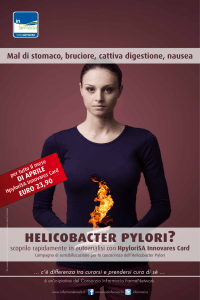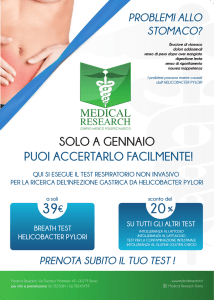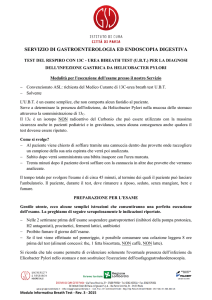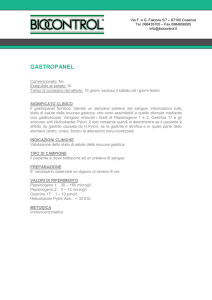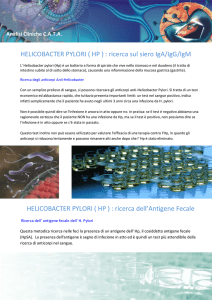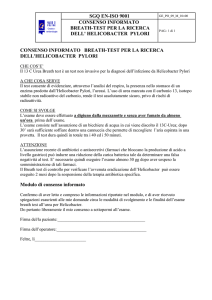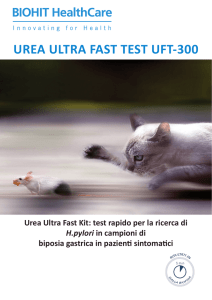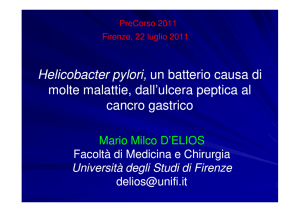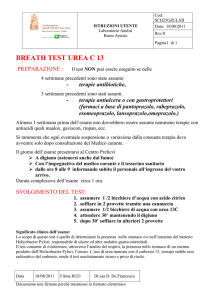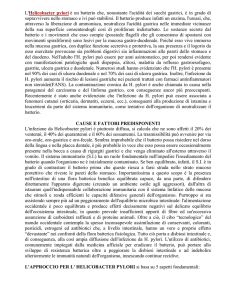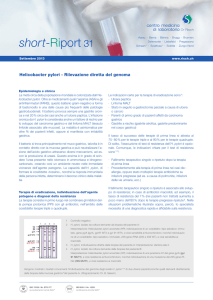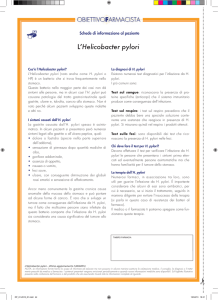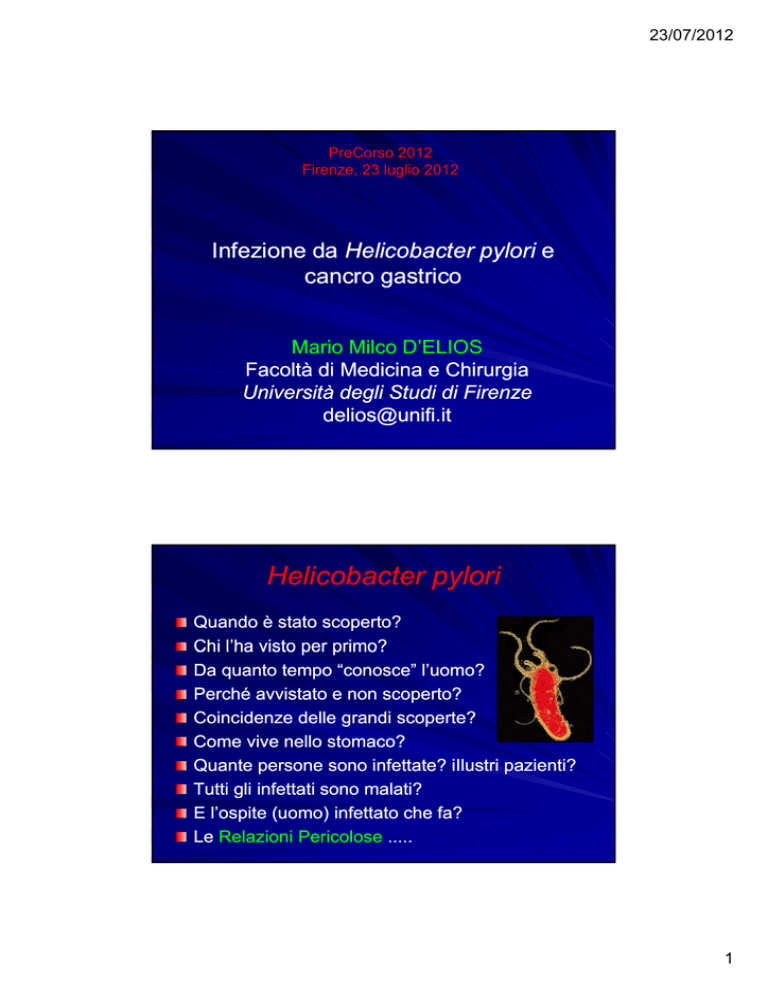
23/07/2012
PreCorso 2012
Firenze, 23 luglio 2012
Infezione da Helicobacter pylori e
cancro gastrico
M i Milco
Mario
Mil D’ELIOS
Facoltà di Medicina e Chirurgia
Università degli Studi di Firenze
[email protected]
Helicobacter pylori
Quando è stato scoperto?
Chi l’ha
l ha visto per primo?
Da quanto tempo “conosce” l’uomo?
Perché avvistato e non scoperto?
Coincidenze delle grandi scoperte?
Come vive nello stomaco?
Quante persone sono infettate? iIlustri pazienti?
Tutti gli infettati sono malati?
E l’ospite (uomo) infettato che fa?
Le Relazioni Pericolose .....
1
23/07/2012
The Nobel Prize in
Physiology or
Medicine 2005
"for their discoveryy of the bacterium
Helicobacter pylori and its role in gastritis and
peptic ulcer disease"
b. 1951
Barry J. Marshall
Australia
J. Robin Warren
Australia
Perth,
A
Australia
li
Helicobacter pylori
Research
Laboratory, QEII
Medical Centre;
University of
Western Australia
Australia
b. 1937
E 100 anni prima
Premio Nobel
a chi?
The Nobel Prize in
Physiology or
Medicine 1905
"for his investigations and
di
discoveries
i iin relation
l ti tto
tuberculosis"
Robert Koch
Germany
Institute for Infectious
Diseases
Berlin, Germany
b. 1843
d. 1910
2
23/07/2012
Helicobacter pylori
quando è stato scoperto?
Cultured for the first time on Easter Thursday 1982
–Patient
Patient 37,
37 70y.o.
70y o male
–DU, GU, artificial valve, anticoagulants
MRSA epidemic at Royal Perth
–Overworked microbiology technologists
– No time to check the culture on Saturday
–Not examined until Tuesday Not examined until Tuesday
–Gram
Gram negative rods seen in pure culture
We had been using the right methods for
–Cultures were being discarded after 48 hours
From the 2005 Nobel Lecture by Barry Marshall
… e 100 anni prima?
The first report on the etiology of tuberculosis was
presented on March 24, 1882 in Berlin.
3
23/07/2012
Helicobacter
chi l’ha visto per primo? quando
quando?
?
Giulio Bizzozzero
1893,, Arch f mikr Anat 42
1893
42:: 8282-152
152..
”Ueber die schschlauchformigen drusen
des
magendarmkanals
und
die
bezienhungen ihres epithels zu dem
oberflachenepitel der schleimhaut.
schleimhaut.”
1892, Atti della Reale Accademia
1892,
delle Scienze di Torino 28
28:: 233233-251
251..
”Sulle
ghiandole
tubulari
del
tubo
gastroenterico e sui rapporti del loro epitelio
coll’epitelio di rivestimento della mucosa.
mucosa.”
Helicobacter
altri avvistamenti
La presenza di batteri spiraliformi nello stomaco fu descritta
a più riprese nel secolo scorso, tra gli altri da Freedberg nel
1940 a Steer e Colin
Colin--Jones nel 1975
1975..
Ito descrisse e fotografò batteri spiraliformi in biopsie
derivate dal suo stomaco, nel suo famoso Textbook of
Physiology del 1966
1966..
Tra gli anni 20 e 50 del ‘900 altri scienziati, quali Luck e
Fitzgerald,, comprovarono la presenza di attività enzimatica
Fitzgerald
di tipo ureasi
ureasica
ca nello stomaco di gatti e cani
cani..
Nel 1959 Lieber dimostrò che l’attività ureasica gastrica
poteva essere soppressa con una terapia antibiotica a base
di tetracicline.
tetracicline. Nel 1968 Delluva osservò che animali
mantenuti in condizioni asettiche non presentavano attività
ureasica nello stomaco.
stomaco.
Ma…
Ma
…la presenza di batteri nello stomaco e l’attività ureasi
ureasica
ca
non furono poste in relazione all’insorgenza di patologie
gastroduodenali
Modificato da Warren e Marshall 2005 Nobel Lecture
4
23/07/2012
H. pylori
perché avvistato e non scoperto?
Acid environment kills organisms
The normal stomach is sterile
Bacteria seen are contaminant passing
through, dead or secondary to gastric
lesions such as p
peptic
p
ulcer
ulcer.. Just a
secondary infection, due to gastritis
“If it is true, why were they not recognised
before…
before
…”
(From the 2005 Nobel Lecture by Robin Warren))
… perché?
“L’uomo, per sua natura, ha più paura
della verità che della morte…
morte…”
Soren Kierkegaard
“…Il più grande ostacolo alla conoscenza
non è l’ignoranza bensì l’illusione della
conoscenza”
Daniel Boorstein
5
23/07/2012
Warren First Report
(From the 2005 Nobel Lecture by Robin Warren))
H. pylori
black bacilli line the pits, easily seen (silver stain)
(From the 2005 Nobel Lecture by Robin Warren))
6
23/07/2012
Lancet Letters 1983
A new species
Bacteria linked to gastritis
- “since the new bacteria are associated with gastritis as
described by Warren, then they may play a role in other
poorly understood gastric diseases i.e. peptic ulcer and
gastric
t i cancer.””
From the 2005 Nobel Lecture by Barry Marshall
Koch’s Postulates …
1. The same organism must
be present in every case
of the disease.
2. The organism must be
isolated from the
diseased host and grown
in pure culture.
3. The isolate must cause
the disease, when
inoculated into healthy,
susceptible animal.
7
23/07/2012
Koch’s Postulates and H. pylori………
From the 2005 Nobel Lecture by Barry Marshall
H. pylori e pazienti nei secoli
Napoleone,, a 52 anni, morì di
Napoleone
“ulcera
antrale
maligna”
(cancro gastrico
gastrico)). Così suo
padre, suo nonno, almeno un
fratello, una sorella
sorella..
Alfred Nobel soffriva di ulcera
peptica!
James Joyce morto di ulcera
duodenale perforata.
8
23/07/2012
H. pylori e pazienti nei secoli
da quanto tempo “conosce” l’uomo?
Traces of human migrations in H. pylori
populations
Falush et al, Science 2003
9
23/07/2012
H. pylori and related clinical outcomes
Helicobacter pylori
infection
Superficial gastritis
Chronic gastritis
Chronic active gastritis
MALT BB-cell
Lymphoma
Peptic
ulcer
Atrophicc gastritis
Atrophi
Gastric
adenocarcinoma
“..Qui
“..
Qui pourrait ne pas frémir en songeant aux malheureux
qui ont causé une seule liaison dangereuse ...”
P. Choderlos De Laclos
Les liaisons dangereuses
D’Elios et al., J Immunol 1997; Gastroenterology 99, 2001; PNAS 2003; J Exp Med 2003
Clin Dev Imm 2012 Trends Mol Med 2004; J Clin Invest 2006; Helicobacter 2009
Gut 2011, Blood 2011, Cancer Immunol Immther 2009, Expert Rev Anti Infect Ther 2010
10
23/07/2012
DIAGNOSI
Per la diagnosi indispensabile eseguire
GASTROSCOPIA
che ha un duplice scopo:
G S OSCO
ACCERTARE L’ULCERA
EFFETTUARE BIOPSIE PER ESCLUDERE
LA PRESENZA DI CANCRO
Diagnosis
Endoscopy reveals the ulcer and allows
biopsy and citology
Biopsy for histopathology
Brushing for cytology mandatory in gastric
ulcers to exclude malignancy
Biopsies can be taken to detect H. pylori
by urease test, histological analysis or
culture
13C Urea breath test (non invasive test)
11
23/07/2012
D’Elios et al, Expert Rev Anti Infect Ther 2010
TERAPIA
ULCERA PEPTICA
Eradicazione Helicobacter pylori
Inibitori pompa protonica (PPI)
Farmaci antianti-H2
Agenti citoprotettivi
Preparazioni
p
contenenti bismuto
Analoghi delle prostaglandine
12
23/07/2012
TERAPIA ERADICANTE
per Helicobacter pylori
T i li tterapia
Triplice
i per una
una--due
d settimane
tti
con:
PPI
20 mg per due al dì
CLARITROMICINA 500 mg per due al dì
AMOXICILLINA 1 gr per due al dì
Suggested anti - HP therapeutic
regimens
Lansoprazole 30 mg twice daily + amoxicillin 1 g
twice daily (or tetracycline 500 mg four times
daily if allergic) + metronidazole 400 mg three
times daily, altogether for 1 week
Lansoprazole 30 mg twice daily + amoxicillin 1 g
twice daily (or tetracycline 500 mg four times
daily if allergic) + clarythromycin 500 mg twice
daily, altogether for 1 week
13
23/07/2012
MAASTRICHTIV/FLORENCE
CONSENSUS
Gut 2012 May;61(5):646May;61(5):646-64.
L
eradicazione di Helicobacter pylori è fortemente
L’eradicazione
raccomandata:
nei pazienti con ulcera peptica
nei pazienti con linfoma gastrico MALT a
basso grado di malignità
nei pazienti con gastrite atrofica
nei pazienti operati di resezione gastrica per cancro
nei parenti di primo grado di pazienti con cancro gastrico
MAASTRICHTIV/FLORENCE
CONSENSUS
Gut 2012 May;61(5):646May;61(5):646-64.
L’eradicazione di Helicobacter pylori è
consigliata:
nei pazienti con dispepsia
nei p
pazienti che devono fare terapia
p anti secretoria
per lungo termine
14
23/07/2012
D’Elios et al Expert Rev Anti Infect Ther 2010
H. pylori, host response, and related
clinical outcomes
Bacterial factors (different strains,
pathogenicity island)
Host factors (genetics, cytokine / chemokine
network, gastrin, somatostatin, pepsinogen,
regulation of acid secretion)
Inflammation (site, type, etc)
15
23/07/2012
Th1 polarization in H. pylori
peptic ulcer
Ag-specificity of gastric Th cells in peptic
ulcer
H.pylori
CagA
VacA
Urease
Hsp
D’Elios et al J Immunol 1997
H. pylori,
pylori, Th1 polarization and peptic ulcer
16
23/07/2012
H. pylori and gastric low grade MALT Lymphoma
Th-dependent enhance
Thenhanced
d B cell help in
gastric low grade MALT Lymphoma
Proliferative response to Hp of B cells
CG
MALT L.
17
23/07/2012
Defective T cell killing in gastric low grade
MALT Lymphoma
D’Elios et al Gastroenterology 1999
H. pyloripylori-induced Th
Th--mediated helper activity
contributes to B-cell growth in gastric
low grade MALT lymphoma
18
23/07/2012
H. pylori and gastric autoimmunity
Proliferative response of gastric Th clones
to H. pylori or to H+K+ATPase
in gastric autoimmunity
Ag-specificity of Th clones in H. pylori
pos Gastric Autoimmunity
14%
12%
10%
8%
H. pylori
H,K,-ATPase
6%
H. pylori & H,K,-ATPase
4%
2%
0%
Amedei et al JEM 2003
19
23/07/2012
H+,K+-ATPase & H. pylori peptides recognized
by cross
cross--reactive gastric Th clones
D’Elios et al Trends Mol Med 2004
9 H. pylori proteins harbour
cross--reactive epitopes to
cross
human gastric proton pump
D’Elios et al Trends Mol Med 2004
20
23/07/2012
H. pylori and autoimmune gastritis
- molecular mimicry In genetically predisposed individuals H.
pylori
infection
can
induce
gastric
autoimmunity..
autoimmunity
Gastric T cells specific for epitopes of some
H. pylori antigens can also recognize crosscrossreactive epitopes of the gastric H+K+ATPase of parietal cells,
cells shifting a defence
mechanism into autoimmunity
autoimmunity..
The results obtained suggest that molecular
mimicry is a relevant pathogenic mechanism in
gastric autoimmunity
autoimmunity..
H. pylori,
pylori, T cells,
cells, gastric autoimmunity
and atrophy
The cross
cross--reactive T cells
display a cytotoxic profile
and provide help for the
synthesis of antibodies.
antibodies.
Cross-reactive T cells are
Crossable
bl to
t induce
i d
apoptosis
apoptosis,
t i ,
thus contributing to the
development of gastric
atrophy .
D’Elios et al Trends Mol Med 2004
21
23/07/2012
H. pylori constituents associated
with gastric cancer
H. pylori Host factor(s)
Hp genotype
associated with
disease
___________________________________________________
CagA
Src kinases, SHPSHP-2,
ERK, ZO
ZO--1, cc-Met
cagA+
VacA
RPTP
RPTP--β
vacA
va
cAs1m1
s1m1
BabA
Lewisb
babA2
babA
2+
SabA
SialylSialyl-Lewisx
sabA+
sabA
+
Inflammation, Gastrin and
Gastric Adenocarcinoma
Gastrin promotes gastric hyperproliferation
(D k
l A
i l 2005)
(Dockray
ett al,
Annu R
Rev Ph
Physiol
In gerbils cag+ strains able to increase gastrin
plasma level induce gastric adenocarcinoma
(Rieder et al, Gastroenterology 2005; Watanabe et al, Gastroenterology 1998;
Honda et al, Cancer Res 1998; Zheng et al, J Gastroenterol Hepatol 2004)
Hypergastrinemic transgenic mice develop cancer
after 2 ys
ys.. The development of cancer is accelerated
by H. pylori infection
infection..
(Wang et al, Gastroenterology 2000; Fox et al, Cancer Res 2003)
22
23/07/2012
Pro-- vs anti
Pro
anti-- inflammatory cytokines
and gastric adenocarcinoma
Polymorphisms
thatt iincreased
pro-inflammatory
P l
hi
th
d proi fl
t
cytokines (IL(IL-1β and TNFTNF-α) increased risk of
gastric cancer
(Machado et al, Gastroenterology 2001, Gastroenterology 2003;
Garza-Gonzales, Int J Cancer, 2005)
Garza-
Polymorphisms
y
p
that decrease antianti-inflammatory
y
cytokines (IL(IL-10) associate with increased risk of
gastric cancer
(El
El--Omar, Gastroenterology 2003)
Hp Team
23
23/07/2012
Acknowledgments
C.Tatiana Baldari (Siena University)
University)
J.L. Telford (Chiron Vaccines
Vaccines,, Siena)
M.
Bernard
Padua
University)
M de
d B
d (P
((Padua
P d University
U i
it )
E. Touati (Institut Pasteur, Paris
Paris))
B.J. Appelmelk
Appelmelk,, M.P. Bergman ((Vrije
Vrije University
University,, Amsterdam)
M. Manghetti
Manghetti,, F. Costa, M. Ferrari (Pisa University
University))
A. Cassone, A. Ciervo (ISS, Rome
Rome))
R. Van der Zee (Utrecht University
University))
+
G. Del Prete , F. Cianchi
Cianchi,, G. Nesi
Nesi,, B. Orsini, C. Surrenti
Surrenti,, S.
Romagnani (Florence University)
University)
24

